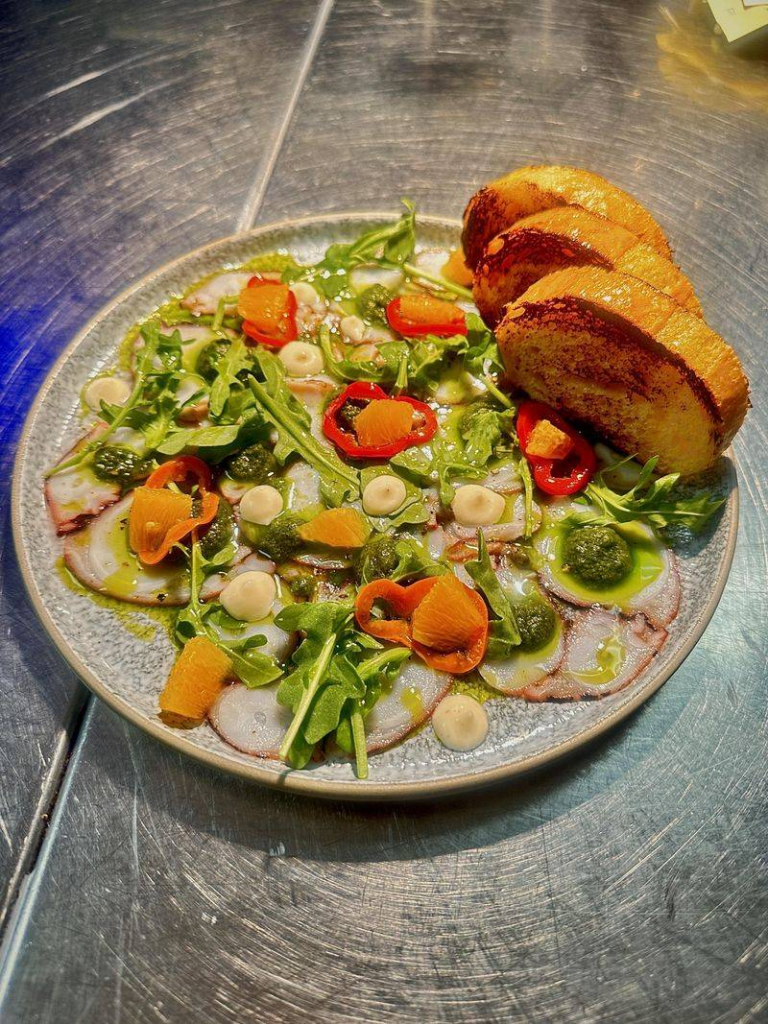Let’s talk about elegance—on a plate. Not the stuffy kind that feels like it belongs behind velvet ropes, but the kind that whispers sophistication with every forkful.
Octopus Carpaccio with Capers and Lemon Zest is one such dish. It doesn’t scream for attention. It doesn’t need to.
With its translucent ribbons of tender octopus, the briny pop of capers, and the fragrant lift of lemon zest, it does what all great dishes do: it tells a story. One of balance, contrast, and finesse.
Whether you’re hosting a dinner party that demands a show-stopping starter or just looking to spoil yourself on a quiet night in, this dish walks the line between effort and elegance with practiced ease.
Let’s dive into the details—not just the how, but the why behind each step. Because once you understand how these flavors come together, you’ll never see seafood the same way again.
Ingredients You’ll Need
Here’s what you’ll need to bring this elegant dish to life:
- 1 whole octopus (about 2 to 2.5 pounds, cleaned)
- 1 carrot, peeled and chopped
- 1 celery stalk, chopped
- 1 small onion, halved
- 2 cloves garlic
- 1 bay leaf
- A handful of black peppercorns
- Kosher salt
- Extra-virgin olive oil
- Juice and zest of 1 lemon
- 2 tablespoons capers (preferably brined, rinsed)
- Fresh parsley (for garnish)
- Crusty bread or crostini (optional but highly encouraged)
- A bottle of crisp white wine (for pairing, but also for sipping while you cook)
Preparing the Octopus
First thing’s first: you need to tenderize the octopus. Some folks swear by freezing it first, as the ice crystals help break down the muscle fibers.
Others pound it with a mallet like a medieval warrior. If you’ve bought your octopus frozen, you’re in luck—it’s probably already been tenderized by nature’s own deep chill.
Bring a large pot of water to a gentle boil, and add your aromatics: carrot, celery, onion, garlic, bay leaf, peppercorns, and a healthy pinch of salt.
This flavorful bath is what your octopus will simmer in for about 45 minutes to an hour, depending on its size. You want it tender enough to pierce easily with a knife but not falling apart. Think: al dente, but for tentacles.
Once done, transfer the octopus to an ice bath to stop the cooking process and preserve that perfect texture.
Forming the Carpaccio
Now, here comes the fun part. Slice off the tentacles and tightly wrap them in plastic wrap to form a cylinder—or better yet, place them in a cylindrical mold (even a plastic bottle with the top cut off works wonders) and press them in tightly.
You want to create a compact shape that will chill and set in the fridge for at least 6 hours, or overnight. The gelatin in the octopus will naturally help it hold its form, resulting in a beautiful, sliceable log.
Once it’s firm and chilled, use a very sharp knife—or a meat slicer if you’re feeling fancy—to cut it into paper-thin rounds. Arrange the slices on a chilled plate in a circular pattern, overlapping slightly.
The Garnish Game
Now comes the moment where the dish goes from delicious to divine. Drizzle the octopus slices with a generous glug of extra-virgin olive oil. Sprinkle over the capers, then shower the plate with fresh lemon zest. Not just a tiny pinch—really go for it. The zest brings a fragrance that elevates everything.
A touch of fresh lemon juice adds acidity, balancing the richness of the oil and the mellow flavor of the octopus. Finish with finely chopped parsley for color and a whisper of earthy brightness.
You can also serve this with thin slices of toasted bread, brushed with olive oil and grilled until golden. The contrast in texture between the crisp bread and delicate octopus is pure pleasure.
Pairing & Presentation
Serve this with a glass of chilled white wine—something bright and mineral-driven like a Sauvignon Blanc or a crisp Albariño. The wine should match the lightness of the dish and enhance the citrus and briny notes.
Presentation-wise, less is more. A white plate, a circular arrangement of slices, a few capers nestled like edible pearls—it’s minimalism with maximum flavor.
With this dish, it’s not just about the ingredients—it’s about how they’re treated, how they play together, and how they create an experience greater than the sum of its parts.
So the next time you want to bring a little culinary poetry to the table, skip the heavy sauces and go for something refined, light, and irresistibly flavorful. One bite, and you’ll understand why less can, indeed, be so much more.

Leave a comment